W
hen Kawasaki debuted the heavily redesigned Z1000 back in 2014, we loved the torquey engine, LED headlights, and stable handling. Then when the smaller Z800 ABS was introduced last year, we were glad that Team Green was entering the supermid naked bike sector with decent performance and a very competitive price. But while the Z800’s overall abilities were more than adequate, we weren’t enamored with the bike’s excessive heft that put it some 80 pounds heavier than the competition. Come to think of it, the Z1000 wasn’t exactly a featherweight either.Fast-forward to 2017, and Kawasaki has now debuted the new Z900 to replace the Z800. (Company reps were coy about whether the 900 would also replace the 1000, but the fact that there’s no 2017 Z1000, plus the price difference—and performance—of the 900 answers that question.) Taking a cue from the Z650 and H2R/H2, the new Z900 ditches both the steel backbone frame of the 800 and the aluminum twin-tube frame of the 1000 for a tubular steel-trellis frame that contributes to a major 46-pound weight savings over the 800 and a 24-pound drop in heft from the 1000.Speaking of the engine, the 948cc four-cylinder is mostly new, though its architecture looks to be based off the newer 1,043cc Z1000 engine instead of the older-generation 800. The stroke is the same 56mm measurement, with bore size shrinking from 77mm to 73.4mm. More influence from the H2R/H2 series comes in the form of pistons using the same casting process for light weight and rigidity; compression ratio remains at 11.8:1.
Up top, 36mm throttle bodies breathe through a dual throttle plate setup for smooth throttle response, with the redesigned cylinder head featuring slightly smaller valves than the 1000 (29mm versus 29.5mm intake, 24mm versus 25.5mm exhaust), along with ports tuned for better breathing at mid-to-high rpm. The 35mm-diameter stainless-steel exhaust headers help high-rpm performance, while the 4-into-1/pre-chamber-into-silencer design permits a smaller muffler. An assist/slipper clutch keeps lever effort low and smooths downshifts, and the first through fifth gearbox ratios are short and close for strong acceleration (sixth is said to be a "true overdrive" gear).
The 41mm KYB inverted fork features adjustable rebound damping and spring preload in the left fork leg, while the rear shock utilizes the same horizontal back-link shock setup as the 650 and 1000 with adjustable rebound and spring preload. That shock works an extruded aluminum swingarm that is claimed to weigh only 8 pounds, further reducing weight. Dual 300mm petal-type brake rotors are clamped by four-piston Nissin calipers, while the single-piston caliper out back grips a 250mm rear disc.
Throwing a leg over the Z900's supportive seat reveals a moderate height of 31.3 inches, but the front portion's narrow midsection makes it feel lower than that. Overall ergos are very similar to the rest of the Z family, with a comfy upright seating position that's just a smidgen on the sporty side. The instrument setup is identical to the Z650 unit, with a circular LCD tach over a smallish LCD info panel—hard to read at a glance and with the Z900's much-increased steam, even harder.
And make no mistake, there’s plenty of acceleration with the Z900. There’s a decent amount of low-end grunt that swiftly transitions to a fat midrange punch around 6,000 rpm that makes the 800 seem positively weak by comparison. But the 900 doesn’t stop there; the power continues building instead of tailing off like most engines that are tuned for bikes of this ilk.
In fact, you'll find yourself bumping into the 11,000-rpm rev limiter in the first few gears if you're not paying attention to the hard-to-read LCD tach. Is it enough to hang with Yamaha's superb FZ-09? Difficult to say for certain without them side by side, but our seat of the pants tells us the Yamaha still has an edge in acceleration.
Overall handling is delightfully neutral, with the steep steering geometry and OEM-spec Dunlop Sportmax D214 tires providing quick steering characteristics while still remaining stable through the rough stuff. Suspension spring and damping rates are biased just a bit toward the sporty side, so the Z900 handles the curves quite well (better than either the 800 or the 1000, in fact) but not so stiff that compliance over nasty urban pavement is compromised. Even the brakes impressed, with the budget-looking Nissin calipers providing surprisingly good power and feel that can haul down the Kawasaki in a hurry with no fuss, even with the ABS models we rode.
Probably one of the more important aspects of the new Z900 is the price. At just $8,399 ($8,799 for the ABS model), the new daddy of the Kawasaki Z lineup is competitively priced with the competition. Looks like the bang-for-the-buck fever is catching on with the manufacturers, and that’s certainly a good thing.










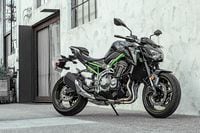
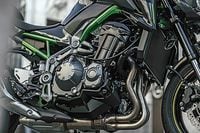
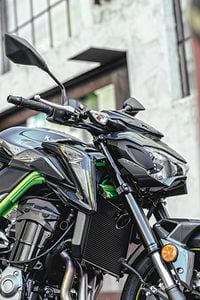
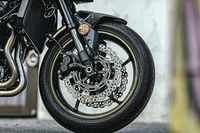
/cloudfront-us-east-1.images.arcpublishing.com/octane/AUE3NFVRRZDSBIDVUGIYIDQNUI.jpg)
/cloudfront-us-east-1.images.arcpublishing.com/octane/LYR62CH2WNBMHJJVXVATZHOUE4.jpg)
/cloudfront-us-east-1.images.arcpublishing.com/octane/RBCTRGBQYBDK7A6XPG3HKPS7ZQ.jpg)
/cloudfront-us-east-1.images.arcpublishing.com/octane/MQXQRYMZVBCWJIRYP3HEN3SHVE.jpg)
/cloudfront-us-east-1.images.arcpublishing.com/octane/TSPODNNEWRDSVJGUCNQTDG4ADI.jpg)
/cloudfront-us-east-1.images.arcpublishing.com/octane/X5TB7BDV4BA2RPSY54ZGK27RP4.jpg)
/cloudfront-us-east-1.images.arcpublishing.com/octane/REUHOJXRDBGZ5IHBYZCCBCISPA.jpg)
/cloudfront-us-east-1.images.arcpublishing.com/octane/52LGJTCKBFEHDF7S7H4CVUIMGM.jpg)
/cloudfront-us-east-1.images.arcpublishing.com/octane/YMWAIPIPSJAOXOU3QMJMGH37OM.jpg)


/cloudfront-us-east-1.images.arcpublishing.com/octane/EJ6KZRGAYBCVXNL2PJXL37UVWQ.jpg)
/cloudfront-us-east-1.images.arcpublishing.com/octane/AAN4TI76M5H5JMUVEIGASWXBDU.jpg)
/cloudfront-us-east-1.images.arcpublishing.com/octane/P3RXD2UCPFF37CMB7CHPVKXORY.jpg)
/cloudfront-us-east-1.images.arcpublishing.com/octane/VZEG2EJI2RDFZNHLRZMU56MD3Q.jpg)
/cloudfront-us-east-1.images.arcpublishing.com/octane/GVJQO5FFOFBWNGODOBRB4FBAW4.jpg)
/cloudfront-us-east-1.images.arcpublishing.com/octane/BIVAK2SFIBDJJM25E7I5VU2FJE.jpg)
/cloudfront-us-east-1.images.arcpublishing.com/octane/CH5VX52UG5CFHOVH5A6UYEFWWA.jpg)
/cloudfront-us-east-1.images.arcpublishing.com/octane/ZVGJNGZRU5C33N7KN23BBFKSC4.jpg)
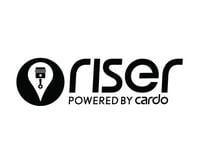
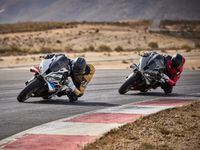
/cloudfront-us-east-1.images.arcpublishing.com/octane/CZ5OM3E43ZEXJHY7LCYXCHLIKI.jpg)
/cloudfront-us-east-1.images.arcpublishing.com/octane/DF5T4K5KPZFJXFCTGPYR77PKJM.jpg)
/cloudfront-us-east-1.images.arcpublishing.com/octane/RMCT2KVQBJHBZMRTSLOVPMOILU.jpg)